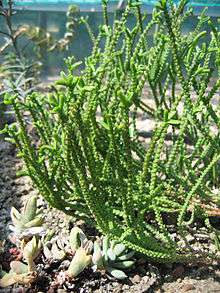Crassula muscosa
Crassula muscosa (Linnaeus, 1760),[1] also named Crassula lycopodioides (Lamarck)[2] or Crassula pseudolycopodioides, is a succulent plant native to South Africa and Namibia, belonging to the family of Crassulaceae and to the genus Crassula. It is a houseplant grown worldwide and commonly known as Rattail Crassula,[2] Watch Chain, Lizard's Tail, Zipper Plant and Princess Pine.
Description
Crassula muscosa has very small, light green leaves that are densely packed around a thin stem, and the arrangement of the leaves around the stems gives them a square shape.[1] It grows as an intricate bush with very small yellow-green flowers, with a maximum height of 15-20 cm. It is an invasive species and easily propagated from stem cuttings. When in flower, the plant can produce a pungent, acrid smell not unlike cat urine.
The scientific and the common names refer to its appearance: muscosa derives from the Latin word muscosus, meaning "mossy". Lycopodioides, referred to the clubmoss Lycopodium, derives from the Greek words "Λύκος" (líkos, wolf), "πόδι" (pódi, foot) and οειδής (oeides, -oid, similar to).
Distribution
Crassula muscosa is native to South Africa (the Cape Provinces, the Free State and the Northern Provinces) and Namibia.[3]
Gallery
Varieties
- Crassula muscosa var. accuminata
- Crassula muscosa var. muscosa[4]
- Crassula muscosa var. rastafarii[5]
- Crassula muscosa var. sinuata[6]
- Crassula muscosa var. variegata
References
- 1 2 Crassula at succulent-plant.com (see the section "Crassula muscosa")
- 1 2 Crassula muscosa at houseplantz.net
- ↑ "Crassula muscosa L.". GRIN Taxonomy for Plants. USDA. Retrieved 2015-08-10.
- ↑ C. muscosa var. muscosa at learn2grow.com
- ↑ C. muscosa var. rastafarii at plantdatabase.ie
- ↑ C. muscosa var. sinuata at tropicos.org
External links
| Wikimedia Commons has media related to Crassula muscosa. |
 Data related to Crassula muscosa at Wikispecies
Data related to Crassula muscosa at Wikispecies- Crassula muscosa at learn2grow.com




